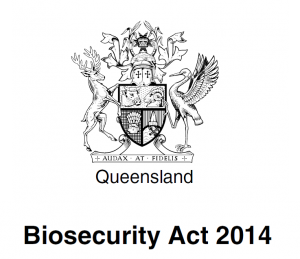Queensland’s new Biosecurity Act
November 24th, 2015
 Queensland will soon have new biosecurity legislation - the Biosecurity Act 2014. To be rolled out from 01 July 2016, the Act makes biosecurity ‘everyone’s responsibility’.
Queensland will soon have new biosecurity legislation - the Biosecurity Act 2014. To be rolled out from 01 July 2016, the Act makes biosecurity ‘everyone’s responsibility’.
To find out what these new responsibilities mean for everyone, we took some time out to talk with John Reeve (Biosecurity Queensland) at the recent Central Queensland, Weed Society of Queensland catch up in Rockhampton.
So what’s coming our way?
General biosecurity obligation
The general biosecurity obligation “requires all persons who deal with biosecurity matter or a carrier, if they know or ought reasonably to know that it poses a biosecurity risk, to take all reasonable and practical measures to prevent or minimise the risk” (s23-28).
This means that anyone (and particularly everyone who occupies land or who is responsible for moving materials), is now responsible to prevent and minimise the risks associated with biosecurity matter.
Under the Act, biosecurity matter (cl. 5 and 15) is defined as:
- Any living thing (other than a human or part of a human)
- Any pathogen
- Any disease
- Any contaminant (anything that may be harmful to animal or plant health or pose a biosecurity risk to human health, social amenity, the economy or the environment).
Prohibited and restricted matter
Under the new Act, weed and pest species, diseases and pathogens may be identified as ‘prohibited matter’ or ‘restricted matter’:
- Prohibited matter - is not established in Queensland and requires a permit to keep. If prohibited matter is found, it must be reported to an Inspector within 24 hours (for example, Chinese stripe-necked turtle).
- Restricted matter - is now identified via 7 risk-based categories instead of the previous 3 classes. Restricted matter must be managed in accordance with the following provisions, unless managed under a permit.
The management requirements for each category are as follows:
- Categories 1 and 2 - high risk diseases, pathogens or species that are not widespread. These species much be reported within 24 hours (for example, bitou bush, hudson pear and samba deer)
- Category 3 - not to be distributed or disposed of (for example, Chilean needle grass, water hyacinth)
- Category 4 - not to be moved
- Category 5 - not to be kept
- Category 6 - not to be fed
- Category 7 - must be killed.
Some species can be identified under a range of different categories. For example, the wild dog is a restricted matter recognised under categories 3, 4 and 6.
New risk-based legislation
The new legislation provides for a more comprehensive biosecurity framework to manage the impacts of animal and plant pests and diseases and ensure the safety and quality of agriculture. The legislation replaces a number of Acts including, amongst others, the Plant Protection Act 1989, Stock Act 1915, Land Protection (Pest and Stock Route Management) Act 2002, Agricultural Standards Act 1994, and the Apiaries Act 1982.
Management plans and permits
Local government pest management strategies will transition across under the new legislation as biosecurity plans. New biosecurity plans must be drafted upon the expiry of existing plans.
All existing permits, exemptions, directions, notices and orders, issued under the Land Protection (Pest and Stock Route Management) Act 2002 will also remain active until their expiry date.
Other powers
The Act also provides a number of additional management instruments including an emergency order, movement control order, biosecurity zones, surveillance and control programs, biosecurity orders and regulatory provisions. There are also some changes to the power of entry and consent procedures.
Further information
It’s early days yet but it looks like the new legislation will streamline management of weeds, pests and other biosecurity threats whilst allowing for greater flexibility in the application of this legislation. We’ll be sure to forward more information as it becomes available.
In the meantime, for further information on the Biosecurity Act, please see the Department of Agriculture and Fisheries website or contact your local officer at Biosecurity Queensland.
The Department also has a regular newsletter called the ‘biosecurity laws alert’. To help prepare your organisation for the introduction of the legislation, these are definitely worth a read. You can sign up here. Or you might like to get into the details and read a copy of the Act here.
TH9 are working with a number of organisations to prepare them for the introduction of the new legislation. If you’d like some help to identify and appropriately manage your biosecurity risks, please get in touch.